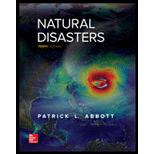
The time required for the operation of a subduction zone as well as a volcano and number of years passed between volcanic eruptions of an active volcano.
Answer to Problem 1QR
The subduction zone requires tens of millions of years to operate, and one volcano would need around millions of years to operate. An active volcano would require around many years to decades for an eruption.
Explanation of Solution
The subduction zone is a type of fault area, which is characterized by the occurrence of swarm of earthquakes. These areas have tremendous amounts of stored energy, which is released periodically in the events of earthquakes. The subduction zone operates only when there is a collision between the plate boundaries or there is an event of oceanic expansion. These processes do not occur frequently. Therefore, subduction zones generally takes tens of millions of years to operate.
Most of the volcanoes require millions of years to operate. Active volcanoes are defined as the type of volcanoes which have undergone at least one eruption in the past 10,000 years. These volcanoes generally take years or decades for a single eruption.
Want to see more full solutions like this?
- Since the 1970s, the median age of people in North America has done what? Increased Decreased Stayed about the same Decreased dramaticallyarrow_forwardNorth America has experienced a demographic transition that resulted in what kind of changes in the population of North America? Lower birthrates, lower death rates, and longer life expectancies Higher birthrates, lower death rates, and longer life expectancies Lower birthrates, higher death rates, and shorter life expectancies Higher birthrates, higher death rates, and shorter life expectanciesarrow_forwardAccording to the views of animal rights activists opposed to animal experimentation which of the following statements applies? Animal experimentation should be permitted only when medical progress cannot be achieved in any other way. Animal experimentation should be permitted only when the animals involved come from a shelter where they were destined to be killed. Animals have the same rights and moral status that human beings do. We should not apply Kant's Practical Imperative to animals.arrow_forward
- 72 ic 18 The planets 1 Can you find eleven Solar System words in the grid? e E W b V e n a e P r r + h C i - PU 0 0 n c e t S c e r P W n P i t e r U 6 r f U n - K σ г m a r S n W e t Y g n d r e E C Y O P U S t a r > S a t U r n 2 Rearrange the letters into the names of the planets. a ucerr My c un Ves e hrtEa g sarM b ruepitj d rntSau f uneNtep_ h nasu Urarrow_forwardAnswer the photoarrow_forwardwhat are your thoughts on the critical importance of soil management and its impact on agricultural productivity and environmental health, and role of conservation tillage. write in first personarrow_forward
- Five arguments that the Water Bottle Bill was passed as a means of "revenue" enhancement In developing your arguments you should start at the website of the Connecticut State Library which contains the history of all legislation passed by the Connecticut Legislature http://ctstatelibrary.org/leghistory_ to gather the information for your arguments. use referencesarrow_forwardDescribe the importance of recycling household solid wastesarrow_forwardWhy is food waste a growing concern? Describe how some communities are addressing the food waste issue.arrow_forward
 Applications and Investigations in Earth Science ...Earth ScienceISBN:9780134746241Author:Edward J. Tarbuck, Frederick K. Lutgens, Dennis G. TasaPublisher:PEARSON
Applications and Investigations in Earth Science ...Earth ScienceISBN:9780134746241Author:Edward J. Tarbuck, Frederick K. Lutgens, Dennis G. TasaPublisher:PEARSON Exercises for Weather & Climate (9th Edition)Earth ScienceISBN:9780134041360Author:Greg CarbonePublisher:PEARSON
Exercises for Weather & Climate (9th Edition)Earth ScienceISBN:9780134041360Author:Greg CarbonePublisher:PEARSON Environmental ScienceEarth ScienceISBN:9781260153125Author:William P Cunningham Prof., Mary Ann Cunningham ProfessorPublisher:McGraw-Hill Education
Environmental ScienceEarth ScienceISBN:9781260153125Author:William P Cunningham Prof., Mary Ann Cunningham ProfessorPublisher:McGraw-Hill Education Earth Science (15th Edition)Earth ScienceISBN:9780134543536Author:Edward J. Tarbuck, Frederick K. Lutgens, Dennis G. TasaPublisher:PEARSON
Earth Science (15th Edition)Earth ScienceISBN:9780134543536Author:Edward J. Tarbuck, Frederick K. Lutgens, Dennis G. TasaPublisher:PEARSON Environmental Science (MindTap Course List)Earth ScienceISBN:9781337569613Author:G. Tyler Miller, Scott SpoolmanPublisher:Cengage Learning
Environmental Science (MindTap Course List)Earth ScienceISBN:9781337569613Author:G. Tyler Miller, Scott SpoolmanPublisher:Cengage Learning Physical GeologyEarth ScienceISBN:9781259916823Author:Plummer, Charles C., CARLSON, Diane H., Hammersley, LisaPublisher:Mcgraw-hill Education,
Physical GeologyEarth ScienceISBN:9781259916823Author:Plummer, Charles C., CARLSON, Diane H., Hammersley, LisaPublisher:Mcgraw-hill Education,





